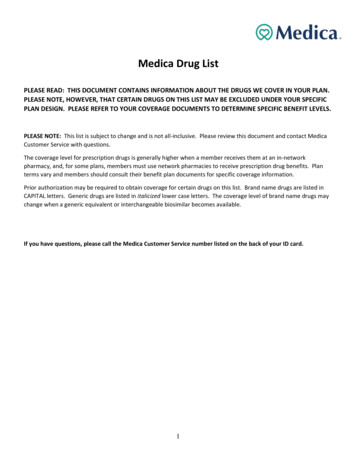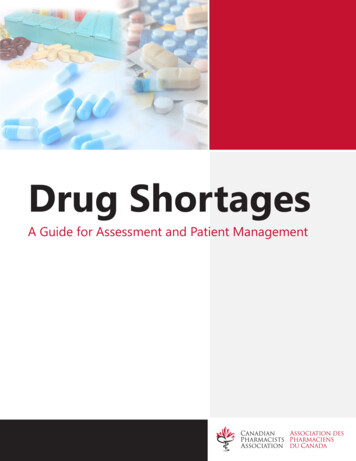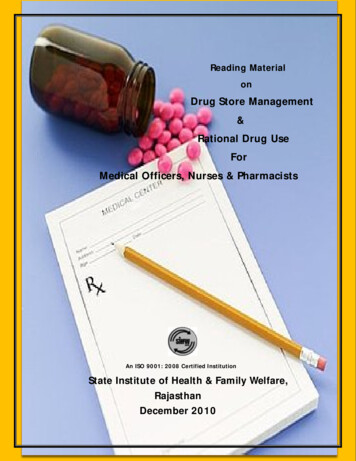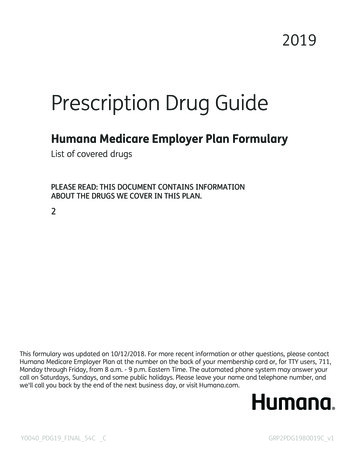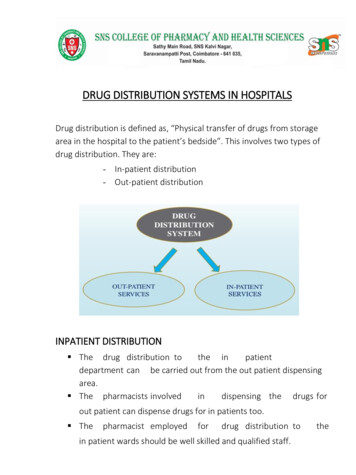
Transcription
DRUG DISTRIBUTION SYSTEMS IN HOSPITALSDrug distribution is defined as, “Physical transfer of drugs from storagearea in the hospital to the patient’s bedside”. This involves two types ofdrug distribution. They are:- In-patient distribution- Out-patient distributionINPATIENT DISTRIBUTION The drug distribution tothe inpatientdepartment can be carried out from the out patient dispensingarea. The pharmacists involvedindispensing the drugs forout patient can dispense drugs for in patients too. Thepharmacist employedfordrug distribution toin patient wards should be well skilled and qualified staff.the
OUTPATIENT DISTRIBUTION Out patient refers to the patients not occupying beds in hospitalor in clinics, health centres and other places where out patientsusually go for health care. No medicaments should be issued without the prescription. After the issue has been made the quantities supplied must berecorded. In short form the out patient department was called as OPD.IN PATIENT
OUT PATIENTTYPES OF DRUG DISTRIBUTION SYSTEMS:There are four different systems in use for drug distribution in hospitals: Individual prescription order systemComplete floor stock systemCombination of individual prescription and floor stock systemUnit dose systemINDIVIDUAL PRESCRIPTION ORDER SYSTEM: It is a type of drug distribution system wherein physician writesthe prescription for individual patient who obtains the drugsprescribed from any medical store or hospital dispensary bypaying own charges. This system is generally used by the small and/or privatehospitals because of the reduced man power requirements anddesirability for individualised service.
ADVANTAGES: All medication orders are directly reviewed by pharmacist. It provides the interaction of pharmacist, doctor, nurse & thepatient. It provides clear inventory control.DISADVANTAGES: Wrong errors, illegible writings of the physicians. Physician may write high economic drugs in the prescription orcost effective drugs.FLOOR STOCK SYSTEM: Drugs are given to the patient from the nursing station& thepharmacy supplies from the drug store. The way of floor-stock distribution includes 2 types They are:1) Charged floor-stock system2) Uncharged floor-stock systemCharged floor stock system: In this method medicines which are stocked in the nursingstations all the times& charged to the patients account afteradministered to them. The patient is charged for every single dose administered tohim. Once the floor-stock list is prepared it is the responsibility of thehospital pharmacist to make the drugs available.Non charged floor-stock system: These system includes the medicaments placed in thenursing station that are used by all the patients on the floor. There shall be no direct charge from the patients account.
COMBINATION OF INDIVIDUAL PRESCRIPTION AND FLOOR STOCKSYSTEM: This system is followed by all government hospitals and alsoprivate hospitals those run on the basis of no -profit and noloss. Surgical items are given to the patients, who purchases anddeposit those items in a hospital wards on rooms under thesupervision of registered headness.UNIT DOSE SYSTEM: Those medications ordered, stored, packed, handed,administrated and charged in multiples of single doesunits containing a predetermined amount of a drug orsupply sufficient for one regular dose. A single unit package is one which contain one completepharmaceutical dosage form. Ex- 1 tablet or 1 capsule.ADVANTAGES Better financial control It prevents loss of partially used medications. Does not require storage facilities at nursing stations.DISADVANTAGES: Irregular dosage skill physician is required for administration of drug. Regular monitoring is required.
pharmacy supplies from the drug store. The way of floor-stock distribution includes 2 types They are: 1) Charged floor-stock system 2) Uncharged floor-stock system Charged floor stock system: In this method medicines which are stocked in the nursing stations all the times& charged to the patients account after administered to them.


